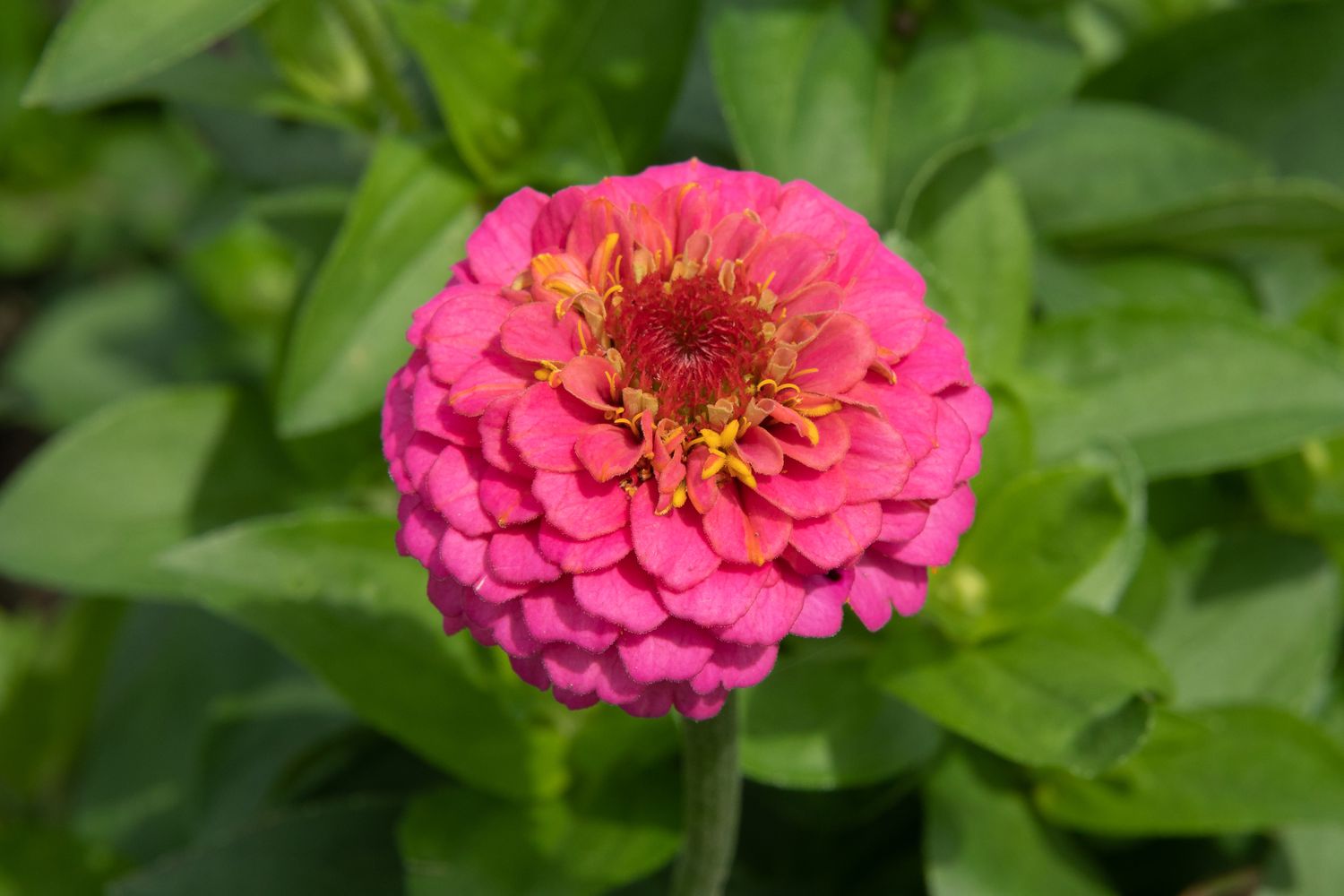
Zinnias are popular and vibrant flowers that have captivated gardeners and enthusiasts for centuries. With their bright colors, diverse varieties, and undeniable charm, zinnias have become a favorite choice for both professional gardeners and beginners alike. However, there is more to these stunning blooms than meets the eye. In this article, we’ll explore 14 intriguing facts about zinnias that will expand your knowledge and appreciation for these remarkable flowers. From their origin and symbolism to their incredible adaptability and unique characteristics, you’ll discover why zinnias truly stand out among the vast array of flowering plants. So, let’s dive in and uncover the secrets and wonders of zinnias!
Key Takeaways:
- Zinnias are vibrant, easy to grow, and attract pollinators, making them a perfect addition to any garden. They symbolize endurance and have medicinal properties, adding both beauty and practicality to your outdoor space.
- Zinnias have a long blooming season, repel pests naturally, and can be used in flower arrangements or dried for crafts. Their edible flowers and wide variety of colors make them a fun and versatile plant to have in your garden.
Zinnia is a Vibrant and Colorful Flower
Zinnias are known for their vibrant colors and come in various shades such as red, pink, orange, yellow, white, and purple. They add a pop of color to any garden or flower arrangement.
Zinnias are Easy to Grow
Whether you are an experienced gardener or a beginner, zinnias are the perfect choice. They are easy to grow, low maintenance, and can thrive in various soil conditions.
Zinnias Attract Pollinators
Zinnias are a favorite among bees and butterflies. Their colorful blooms and nectar-rich flowers attract these pollinators, helping to support the ecosystem and promote biodiversity.
Zinnias Have a Long Blooming Season
One of the great things about zinnias is their extensive blooming season. They typically flower from early summer until the first frost, providing continuous beauty to your garden.
There are Many Varieties of Zinnia
Zinnias come in a wide range of varieties, including dwarf zinnias, tall zinnias, cactus zinnias, and dahlia-flowered zinnias. Each variety has its unique characteristics and flower shapes.
Zinnias Can be Grown From Seeds
You can easily grow zinnias from seeds. Simply sow the seeds directly into the soil or start them indoors and transplant them once the weather warms up. It’s a fun and rewarding experience to watch them grow.
Zinnias Are Symbolic of Endurance
In the language of flowers, zinnias symbolize endurance and lasting affection. These flowers have a strong resistance to heat, drought, and diseases, showcasing their ability to withstand challenging conditions.
Zinnias Can be Used in Flower Arrangements
With their vibrant colors and long vase life, zinnias are a popular choice for flower arrangements. They add a cheerful and lively touch to bouquets and can be combined with other flowers for stunning floral displays.
Zinnias Repel Pests Naturally
Zinnias are known to repel pests naturally, making them a valuable addition to any garden. Their strong scent acts as a deterrent for insects, keeping your plants safe and healthy.
Zinnias Have Medicinal Properties
Aside from their ornamental value, zinnias also have medicinal properties. They contain compounds that have been used in traditional medicine for their anti-inflammatory and wound-healing properties.
Zinnias Can be Dried for Crafts
If you want to preserve the beauty of zinnias, you can dry them for use in crafts. The dried flowers can be used in wreaths, potpourri, or even pressed between the pages of a book as a keepsake.
Zinnias Are Popular in Butterfly Gardens
Due to their ability to attract butterflies, zinnias are commonly found in butterfly gardens. Planting zinnias can help create a welcoming habitat for these majestic creatures and support their lifecycle.
Zinnias Have Edible Flowers
Zinnia petals are edible and can be a unique addition to salads or used to garnish desserts. However, make sure to consume only organic zinnias that have not been treated with pesticides.
Zinnias Are Native to North and South America
Zinnias are native to the Americas and were first discovered in the 16th century. They have since gained popularity worldwide for their beauty and versatility.
Conclusion
In conclusion, Zinnia is a fascinating and beautiful flowering plant that offers numerous benefits to gardens and landscapes. Its vibrant colors, easy maintenance, and ability to attract pollinators make it a popular choice among gardeners. Zinnias are also versatile, with a wide variety of species and cultivars available to suit different preferences and growing conditions.Whether you’re a seasoned gardener or just starting out, incorporating Zinnias into your landscape can add a splash of color and create a vibrant and inviting environment. From their historical significance as a medicinal plant to their ability to thrive in various climates, Zinnias are truly a remarkable addition to any garden.So, why not give Zinnias a try? Plant some in your garden and witness their beauty and charm firsthand. You’ll not only enjoy their stunning blooms but also support pollinators and contribute to the biodiversity of your surroundings. Let Zinnias bring joy and beauty to your outdoor spaces!
FAQs
1. Are Zinnias easy to grow?
Yes, Zinnias are considered relatively easy to grow. They are adaptable plants that can tolerate a wide range of soil conditions and are fairly resistant to pests and diseases.
2. How often should I water my Zinnias?
Zinnias prefer moderate watering. They should be watered deeply once a week, allowing the soil to dry out slightly between waterings. Avoid overwatering, as it can lead to root rot.
3. Do I need to deadhead Zinnias?
Deadheading, or removing spent flowers, is not necessary for the health of the plant. However, it can encourage the growth of new blooms and help maintain a tidy appearance.
4. Can Zinnias be grown in containers?
Yes, Zinnias can be grown successfully in containers. Choose a well-draining potting mix and a container with sufficient drainage. Regular watering and fertilizing will be necessary to ensure optimal growth.
5. Do Zinnias attract pollinators?
Yes, Zinnias are known to attract bees, butterflies, and other pollinators with their brightly colored blooms. They can help support the local ecosystem by providing a food source for these important creatures.
Zinnias offer vibrant beauty, easy growth, and attraction for pollinators. Gardeners adore their long-blooming nature and diverse varieties. Growing zinnias from seeds is a breeze, and their enduring symbolism makes them perfect for any occasion. Arranging zinnias in bouquets or using them to repel pests naturally adds to their appeal. Beyond aesthetics, zinnias boast medicinal properties and edible flowers. Crafters appreciate their ability to be dried for various projects. Native to the Americas, zinnias have captured hearts worldwide. Explore more intriguing zinnia facts, astonishing details about Zinnia peruviana, and captivating information on Zinnia elegans in our other articles.
Was this page helpful?
Our commitment to delivering trustworthy and engaging content is at the heart of what we do. Each fact on our site is contributed by real users like you, bringing a wealth of diverse insights and information. To ensure the highest standards of accuracy and reliability, our dedicated editors meticulously review each submission. This process guarantees that the facts we share are not only fascinating but also credible. Trust in our commitment to quality and authenticity as you explore and learn with us.


